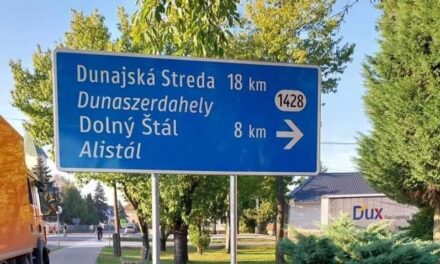Not for the sea, but for the appreciation of multilingualism and the diversity of historical and cultural heritage. A non-standard travelogue with some public life lessons.
When I crossed the border after returning from my summer vacation and felt enough courage to turn the pages of the news pages, the sad case of the Bánffyhunyadi kindergarten immediately came to mind. I could hardly have received a more sobering slap: "back to life", I resignedly acknowledged. All the more so, because the contrast between where I came from and where I arrived - back home, in Transylvania, in Romania - turned out to be quite wide.
Before I explain this, a little digression: I haven't been to the beach for years, last summer, for example, we roamed around the southern part of Bánság, the Al-Danu area, with a group (and among other things we managed to discover a Czech linguistic and cultural island), we also visited Herkulesfürdő , in the former popular spa town of the Monarchy, where the fondly remembered Queen Elizabeth also liked to stay during the happy times of peace. It was a depressing experience to see the population slowly take possession of the once wonderful buildings, the almost complete built historical heritage of this small town (Buziásfürdő is in a slightly better position, at least the colonnade surrounding the park and the pavilions have been restored, but the former villas are still they rot).
It's as if I'm deliberately giving up this place to destruction, which
they try to leach out its past, removing the characteristic Austro-Hungarian elements from it.
Souvenirs depicting Sisi, for example, are rarely (or even) to be found, all the more so for the relics of the Romanian royal couple - the unsuspecting (say, foreign) visitor might think that this city was built between the two world wars, during the Romanian Empire, or at least lived in its heyday.
However, it could be done differently - and there is an example of it. There are places where the remnants of the past handed down to us are valued even if they do not necessarily fit into the framework of the present ruling nation-state. What's more, they recognize the cultural diplomacy and tourism opportunities inherent in it, and build a kind of brand out of its historical heritage, which has long since lost its political relevance, but carries even greater tourist attraction potential.
Opatija (Croatian: Opatija), which is located in the Kvarner Bay between the Croatian mainland, the Istrian peninsula, which mostly also belongs to Croatia, and several smaller islands, can easily be compared to Hercules Bath. In terms of its population, economic and cultural weight, it is a bigger city than the spa town of Bánság, which has seen better days, but it still gained its defining image in the second half of the 19th century, and it was also a popular place of residence for the elite of the Austro-Hungarian Monarchy in the decades after the reconciliation. However, this is considered evidence here,
the K. u. K.'s living heritage of the past has not been erased despite Croatian nationalism: step by step you stumble upon the elements of Habsburg nostalgia in this real jewelry box on the Adriatic coast.
It is enough to look at the multitude of coastal villas that combine the imperial splendor of the Monarchy with Italian, Mediterranean style - and today often operate as expensive tourist accommodation; walk along one of the most beautiful and longest coastal promenades in the Adriatic, the Lungomare, which bears the name of József Ferenc, and where a plaque recalls the figure of Dr. Kálmán Szegő, the creator of medical tourism in Abbázia and the operator of the children's sanatorium there; or to hang out in the Angiolina park with breathtaking vegetation, where the former emperor and king looks at us from a large wall painting with a fake smile (it's true, not alone, but in the "company" of celebrities who used to visit here, such as Gustav Mahler, Isadora Duncan, Albert Einstein, James Joyce or the Lumière brothers).
To an outsider, it may seem strange that the preservation of the memory of the Habsburg era can easily be combined with gestures of respect for the Yugoslav past: the main street running parallel to the coastal promenade bearing the name of the former ruler was named after Marshal Tito, for example - although the South Slavs' recent past in the once "separatist" Croatia it is not clear inside either.
I don't want to idealize the conditions there, since it is a fact that the city, which once had a significant population of Italian, Hungarian, German, and Serbian speakers in addition to Croatian, has now become almost completely "Croatized". Attempts to rewrite the past have also often proved successful; it is enough to think that the graceful seaside sculpture, Girl with Seagull, made in the early 1950s, which is now considered the symbol of Opatija, was once replaced by a Madonna monument. And above all: we must not forget that in the territory of the former Yugoslavia in the nineties, a cruel war raged between the nations that made up the South Slavic state structure...
The memory of the Habsburg past was not forgotten by the neighboring city, Fiume (Croatian: Rijeka), which is considered the shipping center of the Monarchy and is still in a strategic position due to its port. Although it is easy to avoid the commemorative plaque of Gábor Baross, the former "iron minister", who built the port of Fiume, in the port, the city with a troubled fate - during the dualism, although it had a separate status, but was directly part of Hungary, was occupied by the Italian fascists after the First World War, and later for a few years It existed as an independent republic under the name of the Free State of Rijeka, then it was annexed to Italy to be absorbed by Tito's Yugoslavia as a result of the Second World War, and today it belongs to Croatia - a few years ago, the double-headed imperial eagle, banned by both the Italian fascists and the Yugoslav communists, once again adorns the top of its famous clock tower.
Of course, all of this is not independent of the fact that a local autonomist movement, Lista for Fiumérét, has gained strength in the port city in recent years, which is present in about six to seven percent of the local government board, with a meaningful say in the city's affairs. It is among their goals
the increased presentation of the Austro-Hungarian heritage, the re-officialization of the Italian language, the recognition of the culture and language of the national communities that once and/or currently inhabit the city – Croats, Italians, Serbs, Hungarians and others,
gaining a kind of autonomy for the multicultural 'city-state'. So far, they seem to be doing something quite well - perhaps the better-off Transylvanian/Bánská autonomists and Transylvanianists would do well to contact them and study their methods...
Photo: Erdély.ma












